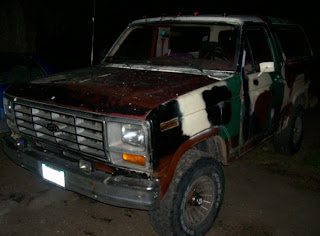
The tie rod ends are soft, not wobbly yet, so they have a while. The inner tie rod on the driver side was the issue. I could grab the inner tie rod and shake it about a half inch. So I took the ball joints back and got a inner tie rod, for about the same price. I should have did the tie rod, the sleeve is fine though.
But being on a tight budget I can only do so much at once. So I changed the inner tie rod, which AutoZone calls the draglink, though I’ve never heard the inner tie rod on the driver side called draglink, that is usually the passenger side on the fords, hooks to the pitman arm.


I changed it out, took off the tie rod, then the inner tie rod. The inner tie rod was really in there I was gentle with the hammer to not damage the side. But it came out. I greased everything, took the tie rod and greased it, greased the boot, and greased the new end, even though it was greaseless. I greased the other side tie rod, and inner end on the passenger too. I used marine grease, all purpose. I choose it over regular front in grease, because the front end of the truck sees a lot of water. A lot of water.

But it didn’t take too long, worse thing was getting those stupid aluminum wheels back on. The outcome? The truck handles much tighter, not as wobbly. It still is a two hander, with the tire treads is has some wander at slower speeds, but not bad.
A tip for this blog, measure your old tie rod before you take it out the sleeve. Measure from the sleeve to the end of the inner tie rod, measure the new one and wrap tape at the length, so when you thread the new tie rod in you get the same length. Too long or two short and your alignment will be screwed.




It is always in the best interest, of both personal safety and vehicle longevity, to not improvise for proper tools. Rotate the steering wheel toward you. This will make it easier to reach the steering components for the side on which you are working.
ReplyDeletePoor steering performance is one of the major problems that can cause by a worn-out tie rod end. Fortunately, it's a problem that you can easily solve by replacing the damaged part with a high-quality aftermarket component.
ReplyDeleteHey there my names dax , I just purchased a 1986 ford bronco myself (Eddie Bauer) Its a fixer uper. First was brakes. A full Over haul on the brake system. Being a novice I Let the pros handle that one. now its on to the front suspension. That's how I stumbled onto this article. I'd love to set up a correspondence. Your advice will be invaluable. Danielalyxandordawkins@gmail
ReplyDeleteHey there my names dax , I just purchased a 1986 ford bronco myself (Eddie Bauer) Its a fixer uper. First was brakes. A full Over haul on the brake system. Being a novice I Let the pros handle that one. now its on to the front suspension. That's how I stumbled onto this article. I'd love to set up a correspondence. Your advice will be invaluable. Danielalyxandordawkins@gmail
ReplyDeletegood one...Tie Rod Systems
ReplyDelete